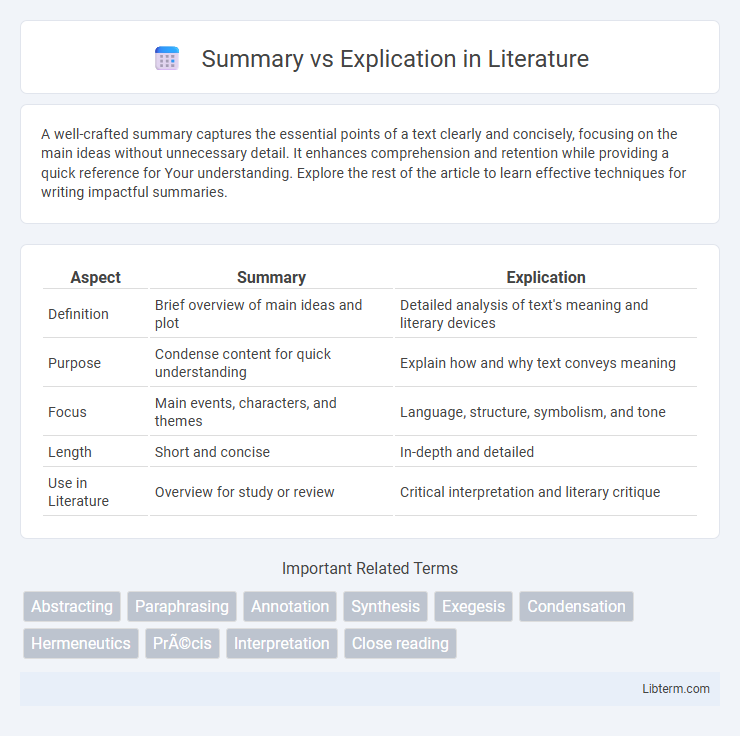A well-crafted summary captures the essential points of a text clearly and concisely, focusing on the main ideas without unnecessary detail. It enhances comprehension and retention while providing a quick reference for Your understanding. Explore the rest of the article to learn effective techniques for writing impactful summaries.
Table of Comparison
| Aspect | Summary | Explication |
|---|---|---|
| Definition | Brief overview of main ideas and plot | Detailed analysis of text's meaning and literary devices |
| Purpose | Condense content for quick understanding | Explain how and why text conveys meaning |
| Focus | Main events, characters, and themes | Language, structure, symbolism, and tone |
| Length | Short and concise | In-depth and detailed |
| Use in Literature | Overview for study or review | Critical interpretation and literary critique |
Introduction to Summary and Explication
Summary condenses the main ideas of a text into a brief overview, capturing essential points without personal interpretation. Explication involves a detailed analysis that explains meaning, structure, and nuances, often uncovering deeper context and symbolism. Understanding both methods enhances critical reading and effective communication skills.
Defining Summary
A summary condenses the main ideas of a text into a brief overview, capturing essential points without detailed explanation or personal interpretation. Its primary purpose is to provide a clear, concise restatement of the original content, highlighting key themes and information. Unlike an explication, which involves deep analysis and interpretation, a summary focuses on brevity and accuracy in presenting the core message.
What is Explication?
Explication is a detailed and systematic analysis of a text, aiming to uncover its deeper meanings, themes, and stylistic elements beyond a simple overview. Unlike summary, which condenses the main ideas into a brief restatement, explication examines the nuances of language, symbolism, and context to interpret the author's intent thoroughly. This close reading method is commonly applied in literature, poetry, and critical writing to enhance understanding and appreciation of complex texts.
Key Differences Between Summary and Explication
Summary condenses the main ideas of a text into a brief overview, highlighting essential points without personal interpretation, whereas explication offers a detailed analysis that unpacks the meaning, structure, and literary devices used. Summaries prioritize brevity and clarity to provide an overall understanding, while explications involve critical thinking and close reading to explain deeper nuances and implications. The key difference lies in the summary's focus on what the text says versus the explication's focus on how and why the text conveys its meaning.
Purposes of Summarizing
Summarizing condenses complex texts into brief overviews, highlighting key points to enhance comprehension and retention. It serves to provide clear, concise information for quick understanding or review without extraneous details. Effective summaries support learning, decision-making, and communication by distilling essential ideas from lengthy materials.
Purposes of Explicating
Explication serves to unpack the underlying meanings, themes, and literary devices within a text, providing a deeper understanding beyond a simple recap. It clarifies complex ideas and explores nuances that a summary cannot capture, making it essential for critical analysis and academic study. This process enhances comprehension by linking the surface narrative to broader interpretive contexts and authorial intent.
Techniques for Effective Summarizing
Effective summarizing techniques include identifying key ideas and main points while omitting extraneous details. Paraphrasing information accurately maintains the original meaning without copying verbatim. Utilizing concise language and focusing on the text's central themes enhances clarity and comprehension in summaries.
Strategies for Writing Explications
Writing effective explications requires closely analyzing the text's language, structure, and literary devices to reveal deeper meanings often missed in summaries. Strategies include annotating key phrases, identifying symbolism, and interpreting tone and imagery to support a nuanced understanding. Explications emphasize detailed evidence and critical thinking rather than condensing content into a brief overview.
When to Use Summary vs. Explication
Use summary when you need to concisely convey the main ideas or key points of a text without detailed analysis, making it ideal for overviews, abstracts, or quick references. Explication is best utilized for deep analysis of a specific passage or element, focusing on meaning, literary devices, and underlying themes to uncover layers of interpretation. Choose summary for brevity and clarity, whereas explication suits in-depth critical examination and nuanced understanding.
Conclusion: Choosing the Right Approach
Choosing between summary and explication depends on the purpose of your analysis; summaries offer concise overviews ideal for broad understanding, while explications provide detailed interpretations suited for in-depth analysis. Effective conclusions in summaries restate key points clearly and succinctly, reinforcing the overall message. In contrast, conclusions in explications synthesize nuanced insights, highlighting deeper meanings and complexities uncovered through close examination.
Summary Infographic

 libterm.com
libterm.com